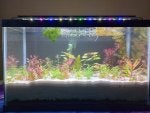Not new to the hobby, and in the past, did "play" with Walstad-inspired tanks and bowls quite successfully. Several months ago, started watching Father Fish' videos, and five days ago (3/28/24), I put together my very first Father Fish-inspired 10 gallon tank. As I later learned, I made a huge mistake by going with Father Fish' older video, in which his recommendation about the content of the dirt is COMPLETELY OFF from his "updated" list today
As I later learned--too late for me, sadly--his "new, updated" list calls for zero compost, zero "snail food" and MUCH less baking soda (in this video above, he uses 1 cup of baking soda per 55 gallon while his current recommendation calls for 1 tablespoon per 100 gallon). So, going by his 4y.o. video--which he clearly was too busy to delete or correct... something I find to be very irresponsible and can't help being very angry about--it would have been 8.7 teaspoons per 10 gallon tank (since there are 16 tablespoons / 48 teaspoons in 1 cup). So, when I put in 5 teaspoons, it felt like "being conservative", "being on the safe side". Instead, going by his "updated list", I am leaps and bounds ABOVE the recommended amount (my tap water here in Arizona is hard as it is). Plus, at least 25% of my dirt is compost, some fish flakes (instead of snail food that he was using in his video), bone meal, also some spirulina powder... so LOTS of organics .
.
Today is day 5. I have a LOT of "pocket spaces" building in the sand layer of the substrate, creating large "cracks". When I pock through the sand with planting tweezers, huge bubbles of gas with a strong odor of rotten eggs (sulfur) come up to the surface. How normal or abnormal is this? My understanding is this being produced by “sulfur bacteria” as the result of decomposition of organics. From what I am reading, “sulfur bacteria” can produce "slime" that feeds other types of bacteria. It does seem like a problematic scenario that can easily lead to bacterial bloom. This sounds like a recipe for disaster. Is this aquarium doomed or there is still hope? Getting it redone is really out of question at this time. Obviously, I will not be putting any fish into this sulfur-burping mess of a tank until and if I am able to stabilize it.
What can I do--if anything--to help this tank be viable long term? Thanks so much in advance!
As I later learned--too late for me, sadly--his "new, updated" list calls for zero compost, zero "snail food" and MUCH less baking soda (in this video above, he uses 1 cup of baking soda per 55 gallon while his current recommendation calls for 1 tablespoon per 100 gallon). So, going by his 4y.o. video--which he clearly was too busy to delete or correct... something I find to be very irresponsible and can't help being very angry about--it would have been 8.7 teaspoons per 10 gallon tank (since there are 16 tablespoons / 48 teaspoons in 1 cup). So, when I put in 5 teaspoons, it felt like "being conservative", "being on the safe side". Instead, going by his "updated list", I am leaps and bounds ABOVE the recommended amount (my tap water here in Arizona is hard as it is). Plus, at least 25% of my dirt is compost, some fish flakes (instead of snail food that he was using in his video), bone meal, also some spirulina powder... so LOTS of organics
Today is day 5. I have a LOT of "pocket spaces" building in the sand layer of the substrate, creating large "cracks". When I pock through the sand with planting tweezers, huge bubbles of gas with a strong odor of rotten eggs (sulfur) come up to the surface. How normal or abnormal is this? My understanding is this being produced by “sulfur bacteria” as the result of decomposition of organics. From what I am reading, “sulfur bacteria” can produce "slime" that feeds other types of bacteria. It does seem like a problematic scenario that can easily lead to bacterial bloom. This sounds like a recipe for disaster. Is this aquarium doomed or there is still hope? Getting it redone is really out of question at this time. Obviously, I will not be putting any fish into this sulfur-burping mess of a tank until and if I am able to stabilize it.
What can I do--if anything--to help this tank be viable long term? Thanks so much in advance!






